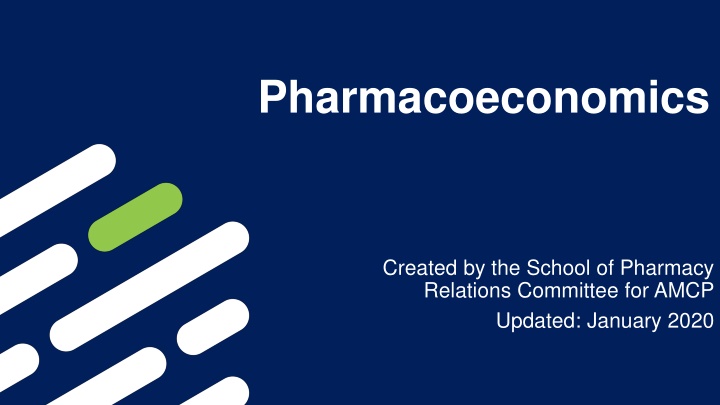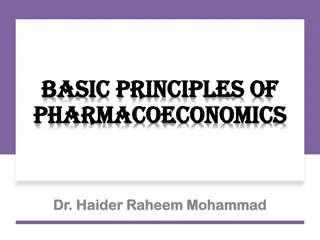
Pharmacoeconomics: Evaluating Costs and Outcomes
Explore the world of pharmacoeconomics, delving into the process of identifying, measuring, and comparing costs and consequences of therapies. Learn about different evaluation methods, such as cost-benefit analysis and cost-effectiveness analysis, and discover the various roles for pharmacists in applying pharmacoeconomics in practice.
Download Presentation

Please find below an Image/Link to download the presentation.
The content on the website is provided AS IS for your information and personal use only. It may not be sold, licensed, or shared on other websites without obtaining consent from the author. If you encounter any issues during the download, it is possible that the publisher has removed the file from their server.
You are allowed to download the files provided on this website for personal or commercial use, subject to the condition that they are used lawfully. All files are the property of their respective owners.
The content on the website is provided AS IS for your information and personal use only. It may not be sold, licensed, or shared on other websites without obtaining consent from the author.
E N D
Presentation Transcript
Pharmacoeconomics Created by the School of Pharmacy Relations Committee for AMCP Updated: January 2020
Objectives Define pharmacoeconomics Differentiate various pharmacoeconomic evaluation methods Discuss various considerations essential to evaluating a pharmacoeconomic analysis Provide examples of how pharmacoeconomics is applied in practice and various roles for the pharmacist
Background - Pharmacoeconomics Process of identifying, measuring, and comparing costs and consequences of therapies and determining which alternative produces best outcomes for resources invested
True or False The goal of pharmacoeconomics is to find the cheapest alternative
Types of Economic Evaluation Economic Evaluation Full Economic Evaluation Partial Economic Evaluation Cost-Minimization Analysis Cost-of-Illness Analysis Cost-Benefit Analysis Cost-Effectiveness Analysis Cost-Utility Analysis
Cost of Illness Evaluation Aims to identify and measure total costs attributable to a particular disease Can demonstrate economic burden of disease Units of Measurement o Cost Monetary ($) o Consequence Not measured
Cost Minimization Analysis Compares costs for therapeutically equivalent drugs to identify the least costly alternative Units of measurement o Cost Monetary ($) o Consequences assumed equivalent
Cost Benefit Analysis Primarily used to determine allocative efficiency Units of Measurement o Cost Monetary ($) o Consequences Monetary ($)
Cost Effectiveness Analysis Compares costs of two or more alternatives versus outcomes measured in natural units (eg: BP, HbA1c) Units of measurement o Cost Monetary ($) o Consequence health outcome (eg: BP, HbA1c) ICER Incremental Cost Effectiveness Ratio ICER = Cost/ Effect = (CTx1 CTx2)/(ETx1 ETx2)
Cost Utility Analysis Analysis that account for both quality and quantity of life which are expressed as utilities o Utilities represent patient preferences and quality of life associated with disease and/or treatment Units of Measurement o Cost Monetary ($) o Consequence Quality adjusted life year (QALY) Quality adjusted life year factor of life expectancy and utility ICER = Cost/ Effect = (CTx1 CTx2)/(QALYTx1 QALYTx2)
Cost Effectiveness Plane 500 Cost 400 More Costly, Less Effective Quadrant II Standard treatment dominant 300 More Costly, More Effective Quadrant I Trade off 200 100 Effectiveness 0 -1 -0.8 -0.6 -0.4 -0.2 0 0.2 0.4 0.6 0.8 1 -100 -200 Less Costly, More Effective Quadrant IV New treatment dominant Less Costly, Less Effective Quadrant III Trade off -300 -400 -500 11
Cost Effectiveness Plane $500 Cost $400 More Costly, Less Effective Quadrant II Standard treatment dominant $300 More Costly, More Effective Quadrant I Trade off $200 $100 Effectiveness $0 -1 -0.8 -0.6 -0.4 -0.2 0 0.2 0.4 0.6 0.8 1 -$100 -$200 Less Costly, More Effective Quadrant IV New treatment dominant Less Costly, Less Effective Quadrant III Trade off -$300 -$400 -$500 12
Recap of Pharmacoeconomic Analyses Model Type Cost-minimization Cost Monetary Consequences Assumed to be equal Aim Efficiency Cost-effectiveness Monetary Health Outcome Determine efficiency when comparators are not therapeutically equivalent Cost-benefit Monetary Monetary Resource allocation Cost-utility Monetary QALY Health related quality of life gains for comparators with similar or different clinical outcome measures
Considerations for Designing or Evaluating Pharmacoeconomic Studies Costs Direct medical e.g., medication and administration Direct non-medical e.g., transportation for treatment Indirect e.g., lost wages due to illness Intangible e.g., pain, suffering Perspective Patient, Provider, Payer, Society Perspective dictates what costs are considered
Considerations for Designing or Evaluating Pharmacoeconomic Studies Discounting - value of money changes over time A dollar is worth more today than in the future Sensitivity Analysis Challenges results and tests assumptions by altering variables Accuracy and transparency Clearly documented study design, assumptions, inputs Face Validity Do the assumptions/input and alternatives reflect reality
Economic Modeling Analytic models used to predict economic consequences of coverage, treatment, and access decisions Constructed by health plans, pharmaceutical manufacturers, academic groups, and consultants These models are associated with uncertainty
One-Way Sensitivity Analysis Change one parameter at a time while keeping all others constant
Probabilistic Sensitivity Analysis Instead of changing one or more variables at a time, all variables are simultaneously changed using a simulation
Applications in Practice & Roles of the Pharmacist Assist in the design and implementation of research studies Evaluate pharmacoeconomic literature Apply results to clinical decision making Individual patient care Formulary/utilization management Disease management Resource allocation
Helpful Resources Navarro RP, ed. Managed Care Pharmacy Practice. 2nd edition. Jones and Bartlett Publishers: Sudbury, MA; 2009. www.ispor.org https://icer-review.org/ https://www.equator-network.org/wp-content/uploads/2013/04/Revised-CHEERS- Checklist-Oct13.pdf Husereau D, Drummond M, Petrou S, et al. Consolidated Health Economic Evaluation Reporting Standards (CHEERS) Explanation and Elaboration: A Report of the ISPOR Health Economic Evaluation Publication Guidelines Good Reporting Practices Task Force. Value in Health. 2013; 16:231-250.
Conclusion Pharmacoeconomic evaluations consider cost compared to consequences of treatment alternatives Results are used to support population-level decisions regarding medication coverage and use Best-Practice principles should be used in designing pharmacoeconomic studies to optimize transparency and reduce bias
Purpose of Quality Measures Quality measures are a mechanism to help quantify the quality of care provided Quality measures address aspects of care such as: Utilization of evidence-based medicine Efficiency and effectiveness Quality of Life Patient Satisfaction Useful in pay-for-performance and value-based purchasing reimbursement programs
Thank you to AMCP member Pranav Patel and Michael Pazirandeh for updating this presentation for 2020.
Mission & Vision To improve patient health by ensuring access to high-quality, cost-effective medications and other therapies.









